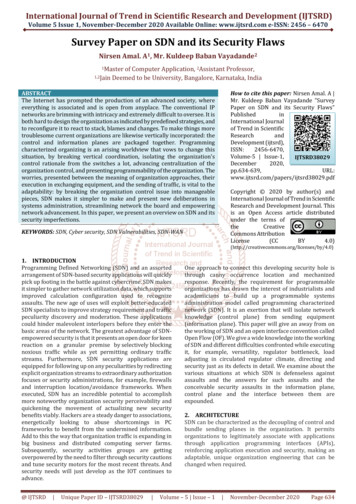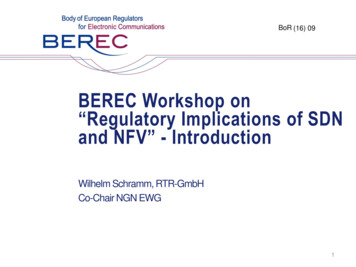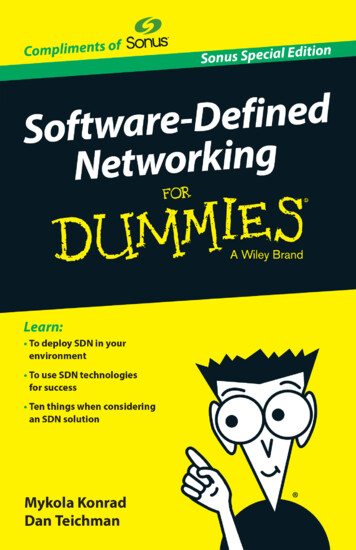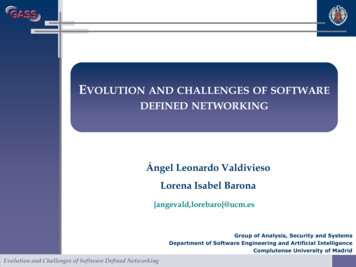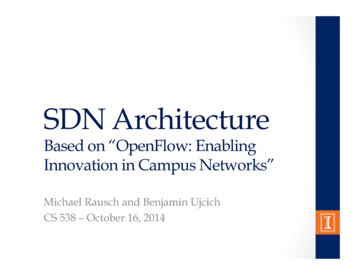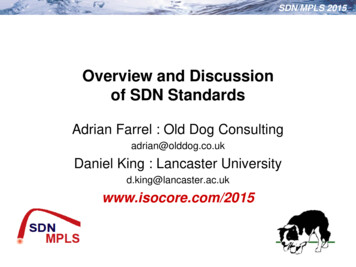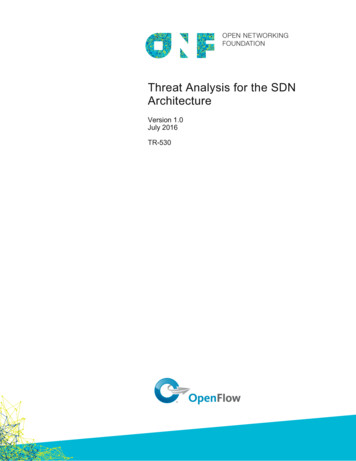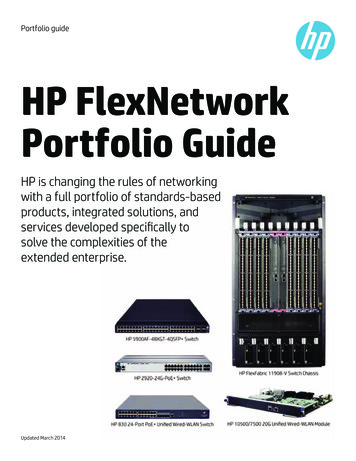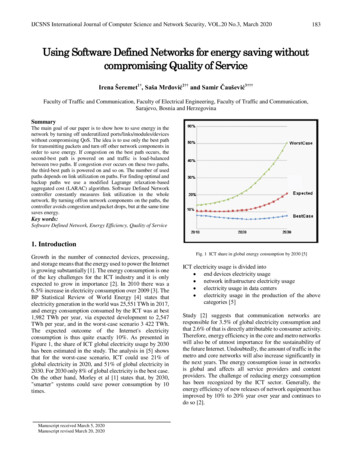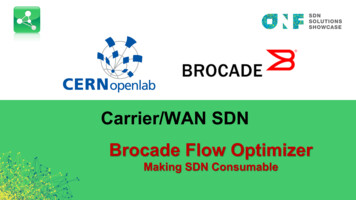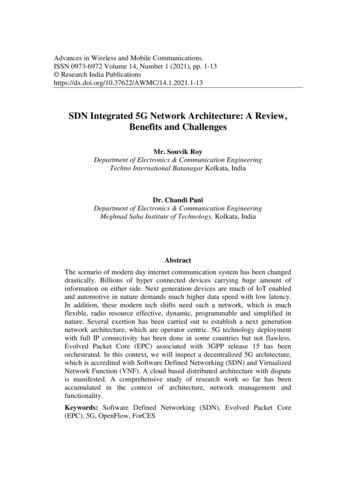
Transcription
Advances in Wireless and Mobile Communications.ISSN 0973-6972 Volume 14, Number 1 (2021), pp. 1-13 Research India 2021.1-13SDN Integrated 5G Network Architecture: A Review,Benefits and ChallengesMr. Souvik RoyDepartment of Electronics & Communication EngineeringTechno International Batanagar Kolkata, IndiaDr. Chandi PaniDepartment of Electronics & Communication EngineeringMeghnad Saha Institute of Technology, Kolkata, IndiaAbstractThe scenario of modern day internet communication system has been changeddrastically. Billions of hyper connected devices carrying huge amount ofinformation on either side. Next generation devices are much of IoT enabledand automotive in nature demands much higher data speed with low latency.In addition, these modern tech shifts need such a network, which is muchflexible, radio resource effective, dynamic, programmable and simplified innature. Several exertion has been carried out to establish a next generationnetwork architecture, which are operator centric. 5G technology deploymentwith full IP connectivity has been done in some countries but not flawless.Evolved Packet Core (EPC) associated with 3GPP release 15 has beenorchestrated. In this context, we will inspect a decentralized 5G architecture,which is accredited with Software Defined Networking (SDN) and VirtualizedNetwork Function (VNF). A cloud based distributed architecture with disputeis manifested. A comprehensive study of research work so far has beenaccumulated in the context of architecture, network management andfunctionality.Keywords: Software Defined Networking (SDN), Evolved Packet Core(EPC), 5G, OpenFlow, ForCES
2I.Mr. Souvik Roy and Dr. Chandi PaniINTRODUCTIONDue to ever emerging growth of data communication over the internet, the nextgeneration network requires high data rate with low latency and enhanced Quality ofService (QoS). A new architectural proposition is necessary to fulfil this resourceconstraint requirement. IP based 5G network is proposed to include all types ofadvanced dominant technologies. Nevertheless, to support different applicationspecific service management with reliability and ensured QoS, standardize newarchitecture is still a challenge. Cloud computing, Internet of Things (IoT), Softwaredefined Network (SDN) now becoming an indispensable core technology for 5Gnetwork. However, the standardize endeavor for 5G are still under its arrival andcomplete realization is forecasted in 2021 in South Korea, Japan China and US[1].Future networks for last couple of decade demand more heterogeneous support whereconnected users ranging from wired, infrastructure based (e.g. celluar-based network,wireless mesh network) to infrastructure-less, wireless network (e.g. mobile ad-hocnetworks, vehicular). Main issues to handle this kind of networks is the resourceutilization efficiently especially in the case of wireless multi-hop ad-hoc network asthe wireless capacity by default limited. That too has to be achieved in ultra-high dataspeed. The expected data rate is 30.6 exabytes produced by the mobile data trafficwith mean connection speed of 3Mbps up till 2017[2].The answer for all these demand is Software Defined Network (SDN) and NetworkVirtualization Function (NVF). Software Defined Network gradually becomes mainsource of attraction from both industry and academic. SDN has the potential to easethe installation and efficient management of network application and service withbetter efficiency. Most witnessed application of SDN is came into light in data centerand cloud computing [3]Rest of the paper is organized as follows: Section II describes the detail literaturereview about the integration of cellular network with SDN. Section III describes thedifference between the features of traditional network and SDN enabled network. Thedetailed structure of SDN architecture is described in section IV. Section V explainsthe different proposed SDN integrated 5G architecture. The challenges and thedifferent design issues are elaborated in section VI and finally section VII is theconclusion of the paper.II.LITERATURE REVIEWA. Cellur Network Architecture through SDNThe first manifestation of SDN enabled celluar network was initiated by LiErrant et.Al. in [4]. They name it CellSDN. Policies for each attribute defined for individualuser in the LTE network. Radio Access Network (RAN) individually handle networkas a collection of base station in which cross functionality is hard to obtain due todistributed coordination algorithm.Manipulation of distinct flexibility can enhance network performance. Soft RAN isproposed by S. Tomovic et al. in [5] used SDN principle in 4G LTE network.
SDN Integrated 5G Network Architecture: A Review, Benefits and Challenges3SDN and SDR are integrated in 5G architecture is proposed in [6] called hybridSDN/SDR. It exploits frequency spectrum and link information in 5G network. Thecontroller distributes the allocation of frequency spread spectrum and the flow oftraffic in an efficient way.SoftAir [7] by Ian F. Akyildizet. al proposed the 5G network exploiting virtualizationfor a strong network. It provides efficient load balancing and resource allocation.Entire phenomenon can be done through logical realization. Different algorithm andprotocol has been established in virtual network.Next generation network architecture design parameters like higher capacity, higherdata rate, low latency, a large number of device connectivity, less expenditure andoperational cost of the network operator should be addressed. A generalized softwaredefined wireless network architecture with common Core Network (CN) functionsalong with design consideration have been presented in [8]. CN functionalities and anumber of Radio Access Network (RAN) defined by a single SDN controller named asSoftware Control Radio.Software Control Radio, an integrated management of celluar network proposed inSDN&R [9]. Radio status and information in the control plane maintained by SDR andit is implemented in base station (BS). Radio allocation accomplished by OpenFlowenabled control plane in base station (BS).B. Cellur Network Management through SDNJararweh et al. in [10] proposed a framework model for IoT management and controlbased on SDN. Different configurations of SDSys (SDN, SDStore and SDSec)advocated and elaborated. Data is collected from the sensor board and send to IoTbridge. This information is passed to SDSec in next phase where SDSec is a variant ofSDSys. A database is maintained to authenticate the device.M. Boussard et al. [11] introduced SDN based network management, control andsolution for IoT devices where many devices connected together in a smartenvironment. By imposing SDN principle and logical abstraction of the devices, asoftware-based solution proposed named as “Software Defined LANs (SD-LAN)”.This plan uses Universal Plug and Play (UPnP) and Simple Services DiscoveryProtocol (SSDP) for finding new devices. Author also the shown prototypeimplementation for home network.C. Network Security Management through SDNSecurity issue is an important concern in celluar data network. However, it has notdiscussed much latest research papers. Aaron Yi Ding et. Al. discussed securityconcern for wireless mobile network [12]. Author advocates that the way forward is tointegrate SDN and fully utilize its feature to solve the problem.As far as the security, concern SDN enabled network subdivided into enterprise
4Mr. Souvik Roy and Dr. Chandi Paninetworks, cloud & data center, home & edge access and general design. For enterprisenetwork Ethane controller [13] impose the network security better than OpenFlowcontroller does by considering central network management, regulation andauthentication process.Another endeavor is Resonance [14] which apply SDN to control the access of IoTdevices dynamically in enterprise or campus environment. It embrace dynamic policyspecification framework and rely on OpenFlow based programmable switches andcontroller for distributed network monitoring. The key point of Resonance is dynamicaccess control in which network devices can treat traffic differently by following thecontroller’s view toward end host’s security class and state.The recommendation of SDN based implementation of four algorithms for AnomalyDetection System (ADS) and prescribes software based solution for more specificidentification of malevolent activity in a home network environment is represented in[15]. It is proved to be better that which is being deployed in ISP. These algorithmscan reduce the extra burden of ISP from monitoring a large number of home network.This work need modification of control plane.OpenFlow Random Host Mutation (OF-RHM) [16] mutates the IP-address of endhost randomly and frequently such that launch of attack based on static IP fails. Thismutation of host IP address based on probability algorithm enable to hide the endhost from adversaries’ scanners. This technique is transparent to the host. To providetransparency host’s real IP address (called rIP) keeps intact but OF-RHM associateseach host to a random and short-lived virtual IP address (called vIP). These vIP aretranslated to rIPs before the host and IP mutation is done with high unpredictability ata very high speed to distort the attacker’s knowledge and increase dissuading attackplanning. OF-RHM based on OpenFlow controller but does not consider the featureof local optimization, mobile scenario or cross- domain interoperability.NetFuse [17] another proposal for cloud and data center based environment wherelarge network suffers failure and performance deformation due to external (e.g. DDoSattacks) and internal (e.g. workload changes, operator error, routing misconfiguration).NetFuse lies between switches and controller of OpenFlow network. To relieve thelarge network pressure from the controller and improve the efficiency NetFuse usesthree steps: (1) Uses OpenFlow control message to determine a number of activenetwork flows. (2) To identify the overloading behavior NetFuse uses a multidimensional, flow aggregation special algorithm, which detect only the cluster ofactive flow. (3) NetFuse deploy toxin-anti-toxin mechanism that adaptively modify thedata rate to resist the malicious flows. NetFuse also rely on the OpenFlow standard butdoes not modify the control plane and data plane.CloudWatcher [18] a new framework based on SDN constantly keep an eye overservices in a large and adaptive cloud network. CloudWatcher controls the data flowto remove all unnecessary data packet inspected by some security device. It writes apolicy script language to empower network administrator use this framework withoutany difficulty. This framework does not change control and data plane but utilizesrouting algorithm for security monitoring.
SDN Integrated 5G Network Architecture: A Review, Benefits and Challenges5III. SOFTWARE DEFINED NETWORK (SDN) VS TRADITIONAL NETWORKIn traditional network data packets transmitted from point-to-point through routersand those routers governed by routing protocol like ICMP, TCP/IP etc. Routingprotocol creates table to find the best route to transmit data packets. Router transmitsdata packets with header to adjacent router and determine the best route or lesscongested route to the destination. This can be accomplished by control plane of theeach router. By this way router transmits data packet to the end user as shown in fig.1. On the contrary, of this if receiver send acknowledgement or any information to thesender it is not necessary that data packet have to be travelled through the same route.It depends on the particular router each time.Fig 1. Traditional Network ArchitectureIn counterpart of this scenario, Software Defined Network (SDN) divides each routerin control plane and data forwarding plane. Control plane is responsible for findingout the less congested route and act like a brain of the router. On the other hand, dataforwarding plane only forward the packets. In software defined network (SDN)traditional routers replaced by SDN enabled router where data-forwarding plane onlyresides in the router and control plane replaced by a centralized SDN controller,which acts like a brain of the entire router as exhibited in fig. 2. All the routersconnected with the SDN controller either physically or through cloud. Since therouters exits only with data forwarding plane, it can be replaced by normal switchwith TCAM hardware. Whenever data packet need to be transmitted, the SDN
6Mr. Souvik Roy and Dr. Chandi Panicontroller predetermines the best route. Therefore, routers do not have to checkrouting table before forwarding to the adjacent router. The biggest advantage of this,it enhances fast forwarding of data from one end to other. Routers from differentvendors or different models of the same vendor comes with five hundred pages ofdata sheet with it. As the network expands, network engineer have to configure eachrouter individually. This overhead burden minimized if all routers replaced by SDNenabled router and SDN controller. In addition, routers which re very costly in themarket replaced by normal switch, so this type of arrangement is very cost effective.Once the SDN controller established in the network, network security is alsocentralized. Proper firewall deployed in the SDN controller to drop the unwanted datapacket.Fig. 2 Software Defined Network ArchitectureIV. SOFTWARE DEFINED NETWORKING (SDN) ARCHITECTURESDN is three-layer architecture (1) Data plane layer, (2) Control plane/controllerlayer, and (3) Application layer depicted in fig. 3. SDN layers communicate eachother layer via open API called Northbound Interface (NI) API and SouthboundInterface (SI) API.There are two well-defined architecture has been realized yet, ForCES and OpenFlow.These are software-based controller. In case Forwarding and Control elementseparation (ForCES) the separation between forwarding and control element remainssame as per the basic concept SDN.
SDN Integrated 5G Network Architecture: A Review, Benefits and Challenges7Communication carried out through ForCES protocol and the protocol based on masterslave model where forwarding element (FEs) are slaves and control element (CE) aremaster. ForCES relies on logical functional block.In the counterpart OpenFlow, securely communicate with the controller layer via openflow protocol. OpenFlow controller deals with flow tables where flow entries werewritten. Whenever data packets arrived, header field extracted from packets andmatched with the field entries in the flow table. For successful match with flowentries the proper switch act according to the instruction predefined by the controllerwhether to forward or drop the packet. Now a day’s many controllers are available inthe market such as OpenDaylight [19], Floodlight [20] and NOX/POX [21] etc.Fig. 3 Software Defined Network ArchitectureV.SDN INTEGRATED 5G NETWORKIn coming day’s celluar network will be consists of much of the IoT based userequipment like appliance control system, mobile devices, tablets, industrialautomation device, drone, IoT enabled medical devices, agricultural equipment which
8Mr. Souvik Roy and Dr. Chandi Paniare on move. For these kinds of next generation devices, network accessibility willplay a huge role. Celluar network consists of two parts Radio Access Network (RAN)and Mobile Core is as same as presently existing 4G network depicted in fig. 4.Fig. 4. Celluer Network with RAN and Mobile CoreIn this context realization of the SDN integration in 5G will be depicted in two parts.A. Network Design through SDNRadio Access Network manages radio spectrum and meets the demand of every userand mobile core network decides the switching of packets efficiently. The drasticallychanged next generation network architecture (e.g. 5G) is that the whole network doesnot rely on routing and switching technologies anymore [22]. Next generationnetwork will be able to provide open communication system to cooperate withsatellite system, celluar network, cloud and data centers. The main feature, whichempowers of flexible network, is to add programmability. 5G architecture have (i)different feature for one or more network functions according to the service provided(e.g. different mobility management procedure for different types of traffic) and (ii) tore-design network functions without the need of deploying new hardware entities torun such functions. The term flexibility be well accomplished by disaggregatingcontrol plane and user plane by software-defined networking (SDN) enabled routers.The integration of SDN in 5G architecture adds dynamicity as it enables networkadministrator to establish link and path configuration and placement of differentfunctionalities only to the core Network. Depending upon traffic computationcapabilities disaggregation of U/C plane is implemented and is placed at the edge ofthe network [23]. Core Network is distributed in nature with a distributed corenetwork entities and central cloud. User centric information while establishing callsetup and data connection are stored in a central cloud addressed by a central cloudSDN controller. Whereas core network SDN controller looks after core networkentities, which is again distributed in control plane and user plane entities. Entire corenetwork orchestrated by a central SDN controller. This enables VNF manager todeploy functionalities across virtualized infrastructure. Enhancement from 4G to 5G
SDN Integrated 5G Network Architecture: A Review, Benefits and Challenges9empowers Radio Access Network keeps as intact while changing decentralized corenetwork furnish a complete new method and means to deploy network services,attenuate cost and boost up performance. Total scenario has been depicted in fig. 5.Fig. 5. SDN enabled 5G ArchitectureB. Network Functionility through SDN5G mobile core which 3GPP calls as NG-Core (next generation core) which adoptsmicro service based functionality. Following are the first group of functional blockrun in the control plane and counterpart run in Evolved Packet Core (EPC) illustratedin fig. 6. EPC is the 3GPP’s released version 4G. 5G Core is a new networkarchitecture introduced in the 3GPP Release 15. A bus is connected to the every blockfor traffic forwarding. AMF (Core Access and Mobility Management Function): Deals withconnection establishment, mobility management, user authentication andauthorization. SMF (Session Management Function): Deals each UE (User Entity) session
10Mr. Souvik Roy and Dr. Chandi Paniincluding proper allocation of IP, selection of UP function, QoS and controlaspects of UP routing. PCF (Policy control Function): Manages the policy rules of other CP functionand employ. AUSF (Authentication Server Function): Essentially an authentication server.Second group also run in control plane but not direct counterpart run in EPC UDSF (Unstructured Data Storage Network Function): “Helper” service usedto store structured data in SQL Database” in a micro service based system. SDSF (Strutted Data Storage Network Function): Same like UDSF unlessstructured data NEF (Network Exposure Function): Responsible to select capability to thirdparty services including preparation of translating internal and externalrepresentational of data. NRF (NF Repository Function): Responsible to invent available services. Thisblock can be deployed as a “discovery service” in a micro service basedsystem. NSSF (Network Slicing selector Function): Responsible to select logicalnetwork slice to serve a given UE. It is a means to allocate different networkresources allocated to different user. NSSF completely depends upon theservice provider.Third group runs in the user plane UPF (User Plane Function): Acts as bridge between RAN and internet andforward the traffic to both the side. It is similar to S/PGW combination inEPC. Along with packet forwarding this element is also responsible for policyenforcement, lawful intercept, traffic usage reporting and QoS policing.The key essence of NG core is migration network functionality and signaling on thecloud. Research work has been carried out on cloud migrated architecture are in [24],[25], [26], [27], [28]. Centralized cloud migrated U/C plane separation allowsoperator to be cost effective and less complex as cloud based storage avoids setupcosting of database and servers over the world.Fig. 6. 5G Core Functionality
SDN Integrated 5G Network Architecture: A Review, Benefits and Challenges11VI. CHALLENGES AND BEYONDIn last few sections, we have reviewed the SDN prototype for the applications oncelluar network architecture, celluar network management and network securitymanagement. SDN become has its wide range of uses in enterprise networking, cloudservices and virtualization function, data center, optical network and infrastructurebased and infrastructure less wireless access network. However, these are not errorfree. OpenFlow protocols are becomes widely used now a day among industry andresearchers due to its advantage of table lookup entries. Controller checks the tablelookup entries unlike ForCES. However, OpenFlow suffers high monitoring overheadand incomplete sample information.Though, the centralized approach is an important concern for OpenFlow protocol.Software Defined Networks mostly implemented in virtually centralized controllerarchitecture. In this case, TCAM hardware enabled switches directly connected with acentralized SDN server, which controlled programmatically. This connection is eitherin physical manner or through cloud services. A single point of failure in any pointcan disrupt the total network. In addition, there could be chance of hacking or phishingin centralized SDN server. Though significant efforts has been carried out has beenaddressed in [13], [14], [15], [16], [17] and [18].Cloud services, which demands high bandwidth with low latency (1mS for 5G)whereas bandwidth limitation globally well known.Heterogeneous operational environment and operator with heterogeneous technologiesleading to a complex migration process, privacy issue and QoS pose a huge challengefor SDN security.SDN has inherent characteristic about its receptiveness of deploy any solution need toface challenge of backward and forward compatibility (e.g. 5G and 4G) as the operatorneed to maintain and interconnect with different generation technologies.VII. CONCLUSIONAs a concluding remark, we can say the way future applications mostly depend uponcloud based services, mobile ad-hoc network, vehicular network, self-organizingnetwork by doing that internet communication will becomes the only means of thesociety in coming days. With more and more world population the number ofconnected devices expected to increase by 18-fold up to next couple of years. Tomitigate the demand significant research has to be accomplished to set up unifiedprogrammable unified flawless 5G architecture.REFERENCES[1] W. OBILE, “Ericsson Mobility Report”[2] Sahrish Khan Tayyaba, Munam Ali Shah, “5G Cellular Network Integrationwith SDN: Challenges, Issues and Beyond,” International Conference onCommunication, Computing and Digital Systems (C-CODE), March 2017.
][17][18]Mr. Souvik Roy and Dr. Chandi PaniD. Kreutz, F. M. Ramos, P. E. Verissimo, C. E. Rothenberg, S. Azodolmolkyand S. Uhlig, “Softwar-defined networking: A comprehensive survey,” Proc.IEEE, vol. 103, no. 1, pp. 14-76, 2015.L. Erran, L. Z. Morley and M. J. Rexford, “Cellsdn: Software defined cellularnetworks,” 2012.A. Gudipati, D. Perry, L. E. Li and S. Katti, “SoftRAN: Software definedradio access network,” in Proceedings of the second ACM SIGCOMMworkshop on Hot topics in Software defined networking, 2013, pp. 25-30.H. H. Cho, C. F. Lai, T. K. Shih and H. C. Chao, “Integration of SDR andSDN for 5G,” IEEE Access, vol. 2, pp. 1196-1204, 2014I. F. Akyildiz, P. Wang and S. C. Lin , “SoftAir: A software definednetworking architecture for 5G wireless systems”Comput. Netw.,vol 85, pp. 118, 2015P. K. Agyapong, M. Iwamura, D. Staehle, W. Kiess, A. Benjebbour, “DesignConsideration For a 5G Network Architecture”, IEEE CommunicationMagazine, Nov. 2014.(In press)S. Namal, I. Ahmad, S. S. Saud, M. Jokinen, and A. Gurtov, “Implementationof OpenFlow based cognitive radio network architecture: SDN&R,” WirelessNetwork., vol 22, no. 2, pp. 663-667, 2016.Y. Jararweh, M. Al-Ayyoub, A. Darabseh, E. Benkhelifa, M. Vouk, and A.Rindos, “SDIoT: a software defined based internet of things framework,” J.Ambient Intell. Humaniiz. Comput. Vol.6, no. 4, pp. 453-461, 2015.M. Boussard et al. “Software Defined LANs for Interconnected SmartEnviroment,” in Tele-traffic Congress (ITC 27), 201527th International, 2015,pp. 208-216.A. Y. Ding, J. Crowcroft, S. Tarkoma and H. Flinck, “Software DefinedNetworking for Security Enhancement in wireless mobile networks,” Comput.Netw., vol. 66, pp. 94-101, 2014.M. Casado, M. J. Freedman, J. Pettit, J. Luo, N. McKeown, S. Shenker,Ethane: Taking control of enterprise, in: Proceedings of ACMSIGCOMM,2007.A. K. Nayak, A. Reimers, N. Feamster, R Clark, Resonance:dynamic accesscontrol for enterprise networks, in:Proceedings of ACMSIGCOMM, 2007.S. A. Mehdi, J. Khalid, S. A. Khayam, Revisiting traffic anomaly detectionusing software defined networking in: Proceedings of RAID, 2011.J. H. Jafarian, E. Al-Shaer, Q. Duan, OpenFlow random host mutation:transparent moving target defense using software defined networking, in:Proceedings of ACM HotSDN, 2012.Y. Wang, Y. Zhang, V. Singh, C. Lumezanu, G. Jiang, NetFuse: shortcircuiting traffic surges in the cloud in: Proceedings of IEEE ICC, 2013.S. Shin, G. Gu, CloudWatcher: Network security monitoring using OpenFlowin dynamic cloud networks(or: How to provide security monitoring as a
SDN Integrated 5G Network Architecture: A Review, Benefits and 13service in clouds?), in: Proceedings of IEEE ICNP NPSec Workshop, 2013.J. Medved, R. Vagra, A. Tkacik and K. Gray, “Opendaylight: Towards amodel-driven sdn controller architecture,” in proceedings of IEEEInternational Symposium on a World of Wireless Mobile MultimediaNetworks 2014,2014.S. Floodlight, “OpenFlow Controller,” Web https://githubComfloodlight.N. Gude et al., “NOX: Towards an Operating System for Network,”SIGCOMM ComputCommun Rev, vol. 38, no. 3, pp. 105-110, Jul 2008.W. H. Chin, Z. Fan, R. Haines, "Emerging technologies and research challenges for 5G wireless networks", IEEE Wireless Commun, vol. 21, no. 2, pp.106-112, Apr. 2014.Massimo Condoluci, Toktam Mahmoodi, “Softwarization and Virtualizationin 5G mobile networks: benefits trends and challenges”, ELSEVIERComputer Networks, vol.146, pp. 65-84, December 2018.A. Basta, W. Kellerer, M. Hoffmann, K. Hoffmann, and E.-D. Schmidt, “AVirtual SDN-Enabled LTE EPC Architecture: A Case Study for S-/PGateways Functions,” in Future Networks and Services (SDN4FNS), 2013IEEE SDN for, pp. 1–7, Nov 2013.A. Bradai, K. Singh, T. Ahmed, and T. Rasheed, “Cellular software definednetworking: a framework,” Communications Magazine, IEEE, vol. 53, pp. 36–43, June 2015.P. Agyapong, M. Iwamura, D. Staehle, W. Kiess, and A. Benjebbour, “Designconsiderations for a 5G network architecture,” Communications Magazine,IEEE, vol. 52, pp. 65–75, Nov 2014.P. Demestichas, A. Georgakopoulos, K. Tsagkaris, and S. Kotrotsos,“Intelligent 5G Networks: Managing 5G Wireless/Mobile Broadband,”Vehicular Technology Magazine, IEEE, vol. 10, pp. 41–50, Sept 2015.B. Han, V. Gopalakrishnan, L. Ji, and S. Lee, “Network orinnovations,”Communications Magazine, IEEE, vol. 53, pp. 90–97, Feb 2015.
14Mr. Souvik Roy and Dr. Chandi Pani
the different proposed SDN integrated 5G architecture. The challenges and the different design issues are elaborated in section VI and finally section VII is the conclusion of the paper. II. LITERATURE REVIEW A. Cellur Network Architecture through SDN The first manifestation of SDN enabled celluar network was initiated by LiErrant et. .
